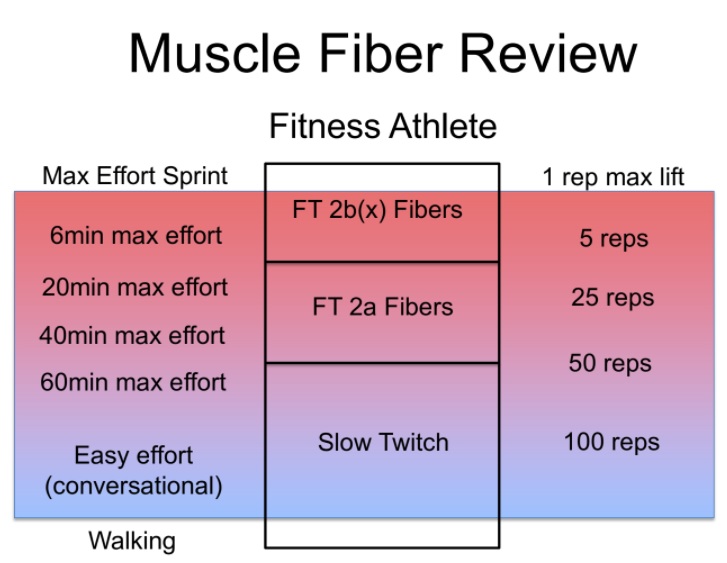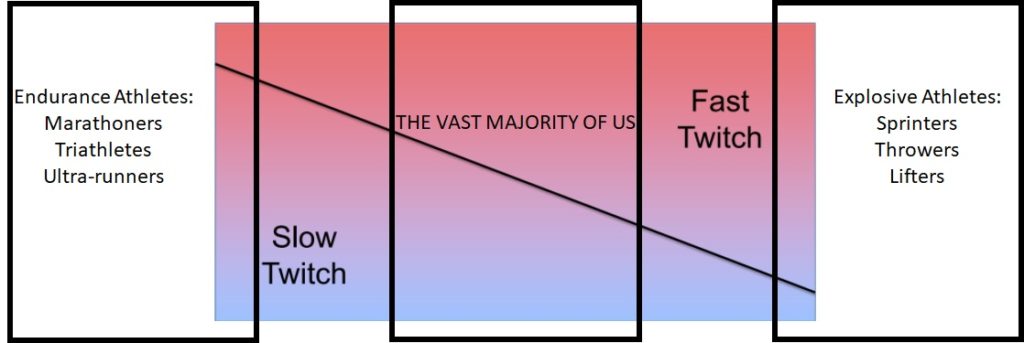In a previous post, we briefly mentioned muscle fiber types. Today we are going to briefly review them, and then more importantly, delve into why we care at all (spoiler alert: it can help you learn about yourself as an athlete and show you where you have the most room to improve!)
So, quick review:

Type 2b (aka type 2x) muscle fibers: these are fast twitch fibers. They are fueled by our fastest burning energy system, the phosphocreatine system. We use them in heaviest lifts and fast sprints.
Type 2a muscle fibers: these are quick twitch muscle fibers. They are fueled by the glycogen system. We use them for heavier weights and longer domain sprints (e.g., a 400m sprint vs. a 100m).
Type 1 muscle fibers: these are slow twitch fibers. They are fueled by the oxidative system. They take the longest to fatigue and are used in longer conditioning or repping out lighter weights.
Okay great, so how do we use this knowledge? It comes into play in several ways. First, by understanding how each fiber type is used, we can understand how to train them. Training fiber types appropriately ensures the best progress for that specific muscle group. If you are not getting stronger in a particular lift, knowing the fiber type of the prime moving muscles can help us better attack that lift with accessory movements.
For example, the shoulder press is the most difficult lift in terms of pure strength. The deltoids and triceps move the weight in this lift. Our deltoids are comprised of more slow twitch fibers than other muscle groups. This means they respond well to high volume training and recover more quickly than other muscle groups. So, we need to adjust our sets/reps and training frequency accordingly. Exclusively training high weights and low reps is not the best way to build these muscles.
Second, everyone is comprised of all three muscle fiber types, but in different proportions. Olympic level weightlifters and throwers are predominately type 2 muscle fibers (~88%). These athletes excel in explosive movements. The repetitions performed are few, but VERY high in power output. World class triathletes, on the other hand, are predominately type 1 muscle fibers (Chris Hinshaw who runs the Aerobic Capacity course is ~87% type 1). They cannot sprint fast, but they can sustain close to max effort output for extended periods of time (marathoners can run ~5-minute mile paces for 26.2 miles, but their fastest mile times likely are not much faster than that.)
Athletes at these extremes reach the levels they do because they are genetically suited for those particular extremes. An Olympic level lifter will likely never have the stamina to be a competitive marathoner, because they do no have the right muscle fiber make up. And, trying to train a genetically perfect fringe athlete for the opposite extreme can detract from their progress. This is how the myth that cArDiO WiLl RuIn mY GaInZ came to be. The good news for us is that most of us fall somewhere around the 50/50 range when it comes to muscle fiber type. So, we can look at our performances and use them to determine what we tend to favor, and where we need to improve.

For instance, let’s look at three hypothetical athletes. Athlete A has not improved his one rep max squat in quite some time, but can rep out 90% for ten reps, and perform it under all kinds of metabolic/muscular fatigue. His type 1 muscle fibers are well developed, and his biggest improvement will come by increasing the ability of his type 2b and type 2a fibers through explosive training. Athlete B can sprint 40 yards in under 5 seconds, but gases out and has to walk when running longer than 200m. His type 2b fibers are well developed, but he lacks the endurance that comes from working type 1 fibers. This is where he can make the most improvement. Athlete C – let’s call him Erik – has a max pace on the rower of 1:12/500m. He can row a 1:50/500m pace for extended periods of time but has trouble sustaining <1:40/500m for longer than a couple minutes with any kind of repeatability. He is pretty decent on opposite ends of the spectrum (type 2b and type 1 fibers), but has a lot of room for improvement in the middle (type 2a fibers). His best bet for improvement would be hitting medium intervals (3-5 minutes of work), and mid-time domain WODs (12-20 minutes) with high output.
By analyzing your performances, we can figure out where you are well developed, and where we can spend time to improve your fitness. And, come the Open or another competition, if we know what your strengths are, we can game each WOD to play to them and maximize your performance. Thanks for reading!
By Erik Castiglione
